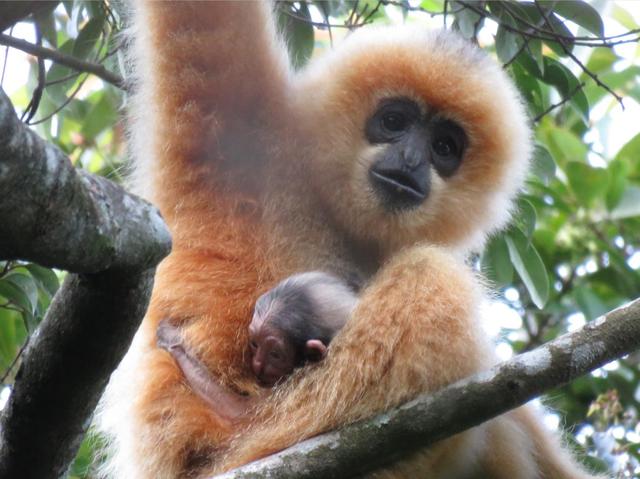Saving species through sound


Sorting out vocal cues
"Hainan gibbons, which are all a golden color at birth, live in trees all their life, and most of their movements are similar to human beings. Their arms are much longer than their legs, and they forage for food-fruit, bird eggs, young tree leaves and insects-up in the canopy around 15 meters above the ground," said Chen, who is familiar with most species and plants in the rainforest.
"At one point, the population of gibbons dropped to less than 10 and only two families in the 1980s. They were easily frightened and living in a fragile environment. But in recent years, they have become bolder. Now they stare at us with curiosity from just a few meters away if we come across them by chance during our daily surveys."
However, it is still difficult to track the gibbons. Protection remains challenging, and according to Wang, at the moment, the most effective way to track the gibbons is by sound.
"Like humans, Hainan gibbons produce vocal cues that can be deciphered to identify specific individuals. Advances in automated methods of collecting acoustic data, including wireless transmission and network storage, can help establish an acoustic database of the gibbons and other vertebrates, and help researchers draw a picture of linguistic structure and patterns of communication," Wang said.
"Analysis of the data, combined with behavioral image monitoring, will help us learn more about their lifestyle and about the ways they express emotions like joy, anger and sadness."
The acoustic monitoring devices don't have lights, which would distract or interfere with the creatures in the forests, making them suited to long-term, large-scale and real-time operations and a popular biodiversity monitoring tool, both domestically and abroad.
Analyzing data
For the next six months, Wang and his team of 10 will work with experts on cloud-storage, AI algorithms and voiceprint analysis programs, including Huawei's, to study data collected over the past year.
Then they will compile an initial report on the voice features of the gibbons, and try to interpret their daily behavior and more precisely determine where they live.
"The database is expected to be completed in three years. It will play a major role in comprehensive biological research and conservation work on gibbons and other rare species in Hainan's rainforests," said Wang, who is the project's leader.
He noted that the acoustic monitoring project is the first of its kind in China, being designed to track all major rare species in a single protected area.
Integrated monitoring systems, including remote sensing satellites, UAVs and ground equipment, have been installed in a number of national parks, including the Northeast Tiger Leopard National Park, the Yunnan Xishuangbanna Nature Reserve and giant panda reserves, to monitor the flagship species in each area, according to conservationists.
They suggested that in the future, research into Hainan gibbon conservation can be extended to interpret their behavior beyond simple communication.
How they choose a mate, for example, can help deepen understanding of human evolution.
They also proposed collecting phenological data, including the varieties of fruit trees that gibbons favor, and information about their predators and competitors.
Since 2005, Hainan has restored more than 330 hectares of gibbon habitat, planting around 300,000 trees that grow either the fruits or the leaves the species eats, and the protected habitat has expanded from 21.4 square kilometers in the 1980s to 4,269 sq km today, according to the park administration.
The steady recovery of the gibbon population in Hainan is evidence of China's achievements in ecological and environmental protection in recent years.
The province's conservation efforts have renewed confidence in the future protection of endangered primates around the world, according to Jane Smart, global director of IUCN's biodiversity conservation group.
Professor Tang Yanfei, executive director of the Hainan National Park Research Institute, said that in accordance with the Hainan gibbon protection action plan, the province will establish a professional monitoring system and strengthen domestic and international cooperation in researching gibbon protection and sustainable community development.
Tang believes that with the new progress on scientific research, habitat restoration and improvements to the rainforest's ecological corridors, the number of gibbons in Hainan should double to around 60-70 individuals by 2035.
- Flag-raising ceremony celebrates Hong Kong's return to the motherland
- Unveiling the impact of China's eight-point decisions
- China to set up first international association on deep-space exploration
- Flags raised as HKSAR marks its birthday
- New Party chief for Xinjiang appointed
- He died for China and is remembered across generations





































